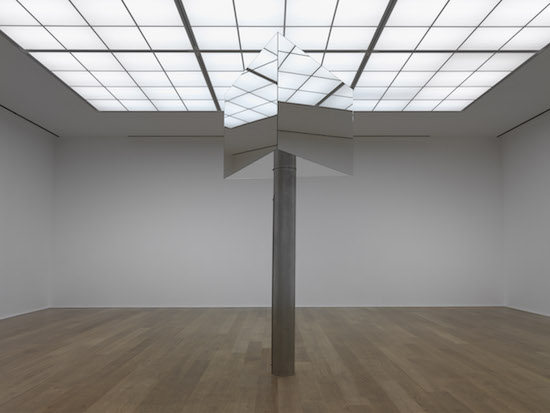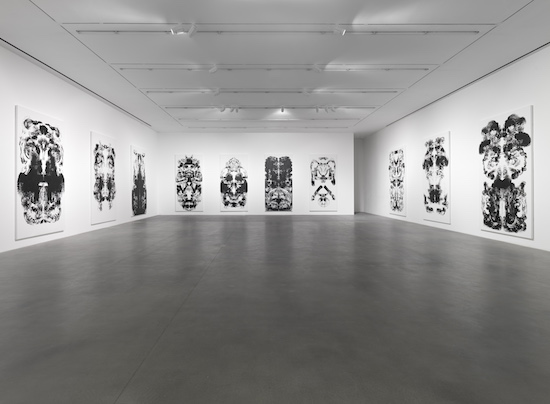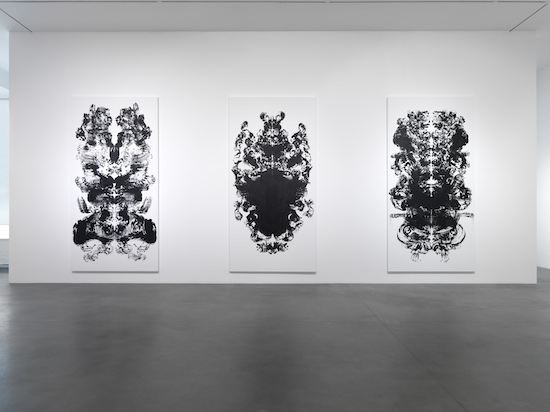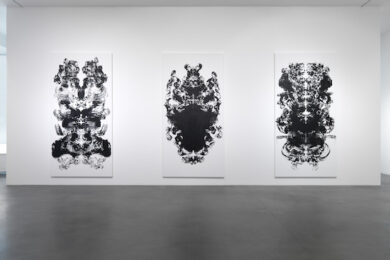All pictures: Installation view, ‘Mark Wallinger. ID’, Hauser & Wirth London, 2016 © Mark Wallinger. Courtesy the artist and Hauser & Wirth. Photo: Ken Adlard
Mark Wallinger is a little on edge. “This is a very vulnerable moment,” he says. How so? I wonder. “Something is suddenly very public all at once, that wasn’t until this very morning.” We’ve been talking about his new exhibition for a little over half an hour, his answers punctuated by furtive tugs on an electronics cigarette. By way of wrapping things up, I ask if there’s anything else he’d like to add. “No,” he starts, “just– ” and suddenly he seems rather small, “I hope people find them of some interest.”
Wallinger is, in some respects, one of Britain’s most visible artists. If you live in London, you probably see his work every day. His Labyrinth, a multi-part artwork comprising a series of 270 different square-framed graphic mazes, has, since 2013, been exhibited in every station on the tube. His Ecce Homo was the first work to occupy Trafalgar Square’s empty fourth plinth. When he won the Turner Prize in 2007, he chose to exhibit a film called Sleeper: 154 minutes of Wallinger himself, in a bear suit, tottering about in Berlin’s Neue Nationalgalerie.
“That was an interesting feeling,” he says now, recalling the nine days he spent in ursine drag in the window of a German gallery. There was then, and is now, in the new works filling up both of Hauser & Wirth’s Savile Row spaces, an odd play of revealing and concealing. “I was kind of naked but in disguise,” he says of the performance whose raw material became the film Sleeper, “I was the artwork.” If he is anxious today about the reception of his latest works, it may be at least in part down to the curiously personal – while still quite oblique – nature of those works. They seem to invite interpretations of a quite intimate nature even as they set out to frustrate those same proclivities.
Take the Id Paintings whose large portrait oriented canvases fill up almost the entirety of the North Gallery. At a glance, they resemble the inkblots used by the Swiss psychologist Hermann Rorschach in his personality tests of the 1920s. As such, they rather call upon the viewer to read through their abstract swirls some concrete referent. Rorschach had employed a set of ten cards bearing the ambiguous designs resulting from a splodge of ink smeared upon paper to encourage his psychiatric patients to free associate. What the subjects read into the designs, and how they articulate what they see, were supposed to have diagnostic value. “Most people,” Wallinger had said earlier as he took a group of journalists around the show, “are probably going to read a skull in that one, second on the left.” I hadn’t, actually, until he mentioned it. But it’s an interesting interpretation.
They are also, as he says, “traces of a performance as much as they’re paintings”. From the 11th of August last year he would proceed, daily, and for some months, to lay a big white canvas on the ground and smear patterns upon it with his bare hands, working in a kind of front crawl to produce the near-symmetry that makes Rorschach blotches so distinctive and recognisable, and then, at a certain point, flipping the canvas round and working on it from the other way. It conjures up a very particular image.
So what happened on August 11th that made you cover your hands in paint and got down on your hands and knees? I ask.
“Yeah,” he says, “it was, like, a – well, it was a little bit of an epiphany, if you like.”

Wallinger’s Id Paintings are but one part of a classic Freudian psychodrama that plays itself out across the galleries’ floors. Between these ids and the door, keeping them in check, as it were, there’s a work called Ego, consisting of two digital prints, photos of two hands touching as per Michelangelo’s Creation of Adam, from the ceiling of the Sistine Chapel, but taken with an iPhone. The hands, in question, symbolically those of both God and his First Man, are both Wallinger’s own.
Finally, over in the south gallery, the triptych is completed by Wallinger’s Superego. This large freestanding sculpture resembles the tri-faced sign outside New Scotland Yard in Victoria, only – like his earlier mirrored Tardis, Time and relative dimensions in space (2001) – made of mirrors. Where the Id Paintings remained studiously obscure, this at least is immediately recognisable. It is authority, branded.
Like all superheroes, this work has an origin story. Part of its inspiration derives from the serendipitous coincidence of Hauser & Wirth’s physical location in London and a nearly thirty year-old reminiscence. Back in 1987, Wallinger was employed by Collet’s, a radical bookshop on the Charing Cross Road. “There used to be an Irish Republican march in Islington every year and the BNP used to go along to have a fight.” A few errant fash wound up making trouble in the bookshop.
“We had a gay section. That was what they seemed to object to, really. So they kicked over a bookshelf. Myself and this friend followed them down the street until – we hoped – we would bump into a policeman. But I got apprehended by one of them.” Badly beaten, Wallinger wound up filing his complaint at West End Central Police Station on 27 Savile Row, just across the street from Hauser & Wirth.
Coming to the gallery to start thinking about arranging the show, he was reminded of the fight and it got him thinking about the nature of the police and their role in society today, about how you might, once, have expected to bump into a policeman if you walk down the street for long enough. “You don’t see that anymore,” he says, “but we’ve got CCTV cameras everywhere. We’ve kind of lost sight of what policing is for. It’s not about just the gathering of evidence, or having something on film. It’s almost like the administrative aspect of policing has overtaken every other. We function just as evidence.”
So the sign revolves and reflects, projecting back only what is around it – in this case, the blank white walls of the gallery. “It redefines the limits of the gallery,” Wallinger says. “It estranges the gallery to an extent and reflects a kind of void.”

Have you been reading a lot of Freud lately, then? I ask
“A bit…” he says, dubiously. “Yeah, I have. But It’s kind of weird in a sense. Because I’m in analysis, I don’t want to academicise my own process. Do you know what I mean? To an extent, I’m looking outside of that and thinking, how is this working? But I’m more interested in it working than how it’s doing it.”
I can’t help but ask – the question literally seems to come out of my mouth without my being able to stop it – have you shown them to your analyst, then, the Id Paintings?
“I have,” he admits, “on my phone,” before deftly changing the subject, “– and they do seem to fit with the iPhone screen proportions well.”
Like the Labyrinths on the tube, there is something distinctly Instagrammable about these paintings. And like an Instagram account, they became, it seems, a means of diarising through image, and not words. A way, perhaps, of thinking through analysis without thinking. A corporeal working through that bypasses the rationalisation he seems to worry might bias the process itself.
But Wallinger himself has no Instagram account. “I’m not on any social media, actually,” he laughs. “I’m a very private person – paradoxically.”
Mark Wallinger’s ID is on show at Hauser & Wirth until 7 May 2016



